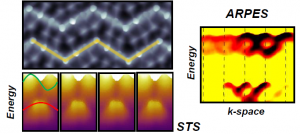Electronic Structure Tunability by Periodic meta-Ligand Spacing in One-Dimensional Organic Semiconductors

Bond-resolution STM image of the zigzag polymer film (top). Bound molecular states localized within the straight segments of the polymer probed by STS (bottom). ARPES electronic band structure of the zigzag polymer chains evidencing shallow dispersive bands (right)
The rapidly progressing on-surface chemistry is a highly versatile bottom-up tool for the controlled-synthesis of atomically precise graphene-based nanostructures. As the resulting polymers are promising candidates for the realization of exotic nanodevices, resolving their electronic structures is key for future technological applications.
In a recent work published in ACS Nano, researchers from CFM and DIPC, in collaboration with international partners, have transformed the electronic band structure of the well-known poly-(para-phenylene) (PPP) by introducing periodically spaced meta-junctions into its conductive path. They have achieved the on-surface synthesis of an extended (saturated) polymeric film, which they have macroscopically aligned on a vicinal Ag(111) surface. The atomically precise cross-conjugated oligophenylene zigzag chains host periodically spaced meta-junctions that remain sufficiently decoupled from each other and from the substrate. The experimentally unreported band structure showing weakly dispersing one-dimensional electronic bands along the chain direction, which fully agrees with the theoretical simulations, is presented in this paper. A significantly larger frontier orbital band gap than for PPP chains is found, which linearly decreases with the length of the straight segments. Moreover, confinement effects are observed between the elbows of the chains, acting as an array of weakly interacting quantum dots whose localized states can be engineered by increasing the separation between meta-junctions.
These findings corroborate the important effects that the conductive path topology of a molecular wire has on its electronic states, which are responsible for defining its chemical, optical and electronic properties. Such arrays of semiconducting quantum dots hold potential for designing future oligophenylene based quantum devices.



